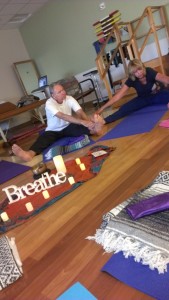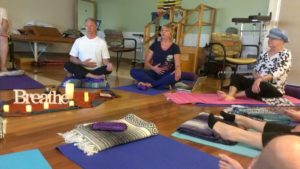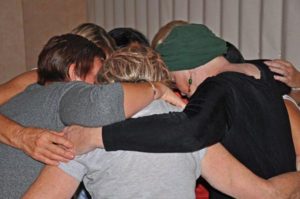Healing breaths; cancer healing with yoga
By Nancy B. Loughlin
Published in News Press on May 21, 2013 Posted with permission.
Cancer patients, cancer survivors and the people who love them are seated in a circle on the floor facing a colorful cloth dotted with candles. They are reminded of the single word that is the core of their healing.
“Breathe.”
Louise, age 75, has been in cancer remission for three years and attends the Pink Ribbon Restorative yoga class each Monday in the NCH Brookdale Infusion Center in Naples.
“I’m more in control, more peaceful…” Louise said.
Pink Ribbon (pinkribbonrestorativeyoga.com) is a non-profit that offers donation-based classes in different styles including restorative, chair/mat, and gentle yoga. Classes are taught by LiRa Bennett, Gretchen Ross and George McDermott.
This practice is for healing.
“This is your breath.” Begin practice by inhaling for a count of four and then exhaling, squeezing out the breath, belly to spine. Feel the rhythm and relaxation of deep diaphragmatic breathing, adding toning or chanting to the exhales. The tongue touches the roof of the mouth in firepoint, an energy point in Chinese medicine that also stops jaw clenching.
This focused breathing, a yogic and relaxation staple, is also linked to vagus nerve stimulation. This nerve stretches from the brain and radiates throughout the abdomen. According to William J. Broad, author of “The Science of Yoga,” recent research shows that activating the vagus nerve stimulates the immune system and helps the body fight inflammation.
This deep breath is “your breath,” not just in class, but throughout the day in all activities.
The Thymus Thump. Some people call this the happiness point. The fingertips tap the breast bone. Think “gentle Tarzan.” As you are tapping and stimulating the thymus, instructor George McDermott suggests chanting, activating the parasympathetic nervous system, and mentally focusing on an object of love. McDermott integrates the principles of Qigong into the restorative practice: movement, breath, and mind combined with focused intention.
Seated Sun Salutation. For people undergoing cancer treatment, standing sun salutations are usually too rigorous. A seated sun salutation offers the same benefits of stretching and stimulating oxygen delivery throughout the body. Click on the online version of this article for a full demonstration.
Hip Swivels. While holding on to the back of a chair, rock your body weight from foot to foot. Then add hip circles both clockwise and counter-clockwise. These gentle hip openers ease tension in the lower back and intensify leg circulation. These hip swivels will release negative energy trapped in the hips. For a demonstration, click on the online version.
Seated Cobblers Pose. While seated on the floor, bring the soles of the feet to touch. As the hips open deeper, massage your feet, lingering over any tender spots. McDermott recommends daily foot reflexology, either solo or with a willing partner, to stimulate the foot nerve endings that reverberate throughout your body.
This pose is particularly helpful in alleviating nausea that can accompany chemotherapy. Sit in Cobbler’s Pose or even cross-legged (perhaps on a pillow) and then add a forward fold with your hands to the floor or a chair.
The practice concludes in Savasana. Lie back with a soft bolster or rolled blanket long enough to run the spine and support your head. If you suffer from headaches, lie on your back with your legs up the wall. Cover your eyes with an eye-pillow; sink into the breath.
George Cohen lives with heart disease, skin cancer, and severe arthritis. He said he never knew what yoga was about, but this practice has pulled him into a quiet meditation and fills his cells and pores with oxygen.
“Now, I’m opening myself up to the sky and warming myself with the sun,” Cohen said.



